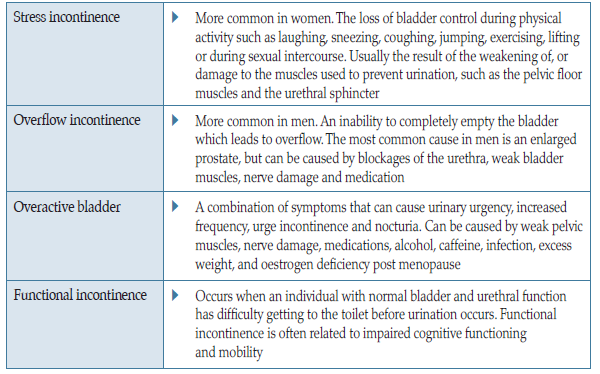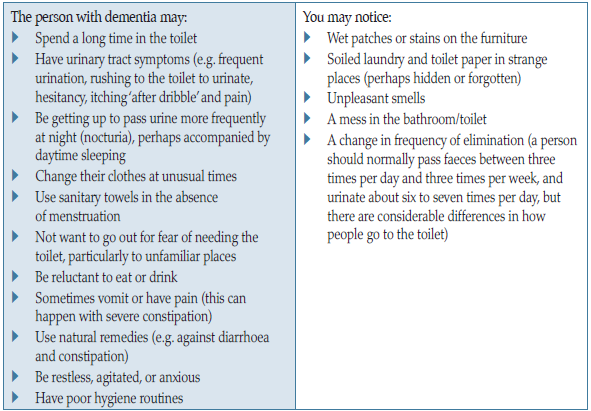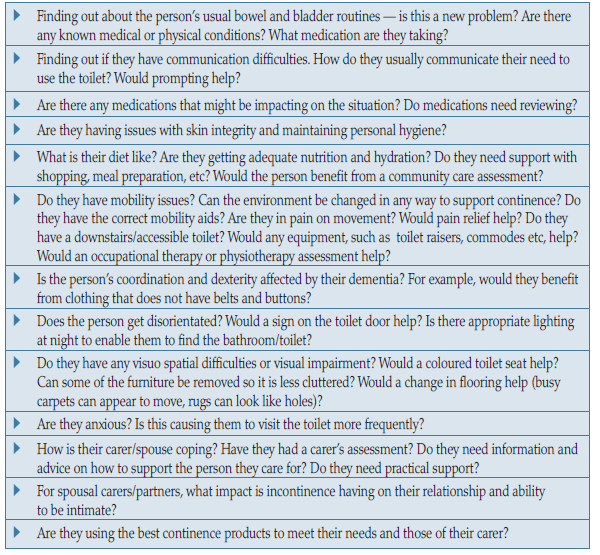References
Alzheimer Europe (2014) Improving continence care for people with dementia living at home. Available online: https://www.alzheimer-europe.org/reports-publication/2014-alzheimer-europe-report-improving-continence-care-people-dementia-living
Baker KL, Robertson N (2008) Coping with caring for someone with dementia: reviewing the literature about men. Aging Ment Health 12: 413–22
Byles J, Millar CJ, Sibbritt DW, Chiarelli P (2009) Living with urinary incontinence: a longitudinal study of older women. Age Ageing 38(3): 333–8
Cole L, Drennan VM (2019) Living with incontinence: The experience of people with dementia. Dementia 18(5): 1826–39
Drennan V, Cole L (2009) Promoting continence and managing incontinence with people with dementia living at home: one more challenge for integration. J Intergrated Care 17(1): 15–25
Drennan VM, Cole L, Iliffe S (2011) A taboo within a stigma? a qualitative study of managing incontinence with people with dementia living at home. BMC Geriatr 11: 75
Drennan VM, Rait G, Cole L, et al (2013) The prevalence of incontinence in people with cognitive impairment or dementia living at home: a systematic review. Neurourol Urodyn 32: 314–24
Garg K, Kishor K, Kar SK (2015) Cholinesterase inhibitor induced urinary incontinence in dementia: a management dilemma. Toxicol Int 22(2): 123
Goodman C, Rycroft Malone J, Norton C, et al (2015) Reducing and managing faecal incontinence in people with advanced dementia who are resident in care homes: protocol for a realist synthesis. BMJ Open 5: e007728
Gove D, Scerri A, Georges J, van Houten P, Huige N, et al (2016) Continence care for people with dementia living at home in Europe: a review of literature with a focus on problems and challenges. J Clin Nurs 26: 356–65
Hägglund D, Wadensten B (2007) Fear of humiliation inhibits women’s careseeking behaviour for long-term urinary incontinence. Scand J Caring Sci 21(3): 305–12
Harwood RH, Cowan R (2021) Physical assessment. In: Dening T, Thomas A, Stewart R, Taylor JP, eds. Oxford Textbook of Old Age Psychiatry. Oxford University Press: chap 11
Hope T, Keene J, Gedling K, Fairburn CG, Jacoby R (1998) redictors of institutionalization for people with dementia living at home with a carer. Int J Geriatr Psychiatry 13(10): 682–90
Kyle G (2012) An insight into continence management in patients with dementia. Br J Community Nurs 17(3): 125–31
Luppa M, Luck T, Brähler E, König HH, Riedel-Heller SG (2008) Prediction of institutionalisation in dementia. A systematic review. Dement Geriatr Cogn Disord 26(1): 65–78
NHS England (2018) Excellence in continence care practical guidance for commissioners, and leaders in health and social care. Available online: https://bit.ly/3oYgPOU
National Institute for Health and Care Excellence (2014) Faecal incontinence in adults (qs54). NICE, London. Available online: https://bit.ly/3DCxuf3
Reppas-Rindlisbacher CE, Fischer HD, Fung K, Gill SS, et al (2016) Anticholinergic drug burden in persons with dementia taking a cholinesterase inhibitor: the effect of multiple physicians. J Am Geriatr Soc 64(3): 492–500
Sharma N, Chakrabarti S, Grover S (2016) Gender differences in caregiving among family — caregivers of people with mental illnesses. World J Psychiatry 6(1): 7–17
Si Ching L (2017) Managing the elderly with urinary incontinence and dementia. Int Arch Urol Complic 3: 027
Spencer M, McManus K, Sabourin J (2017) Incontinence in older adults: the role of the geriatric multidisciplinary team. Br Columbia Med J 59(2): 99–105
Upton N, Reed V (2005) The meaning of incontinence in dementia care. Int J Psychiatr Nurs Res 11(1): 1200–10
Wagg A, Potter J, Peel P, et al (2008) National audit of continence care for older people: management of urinary incontinence. Age Ageing 37(1): 39–44
Wagg A, Gove D, Leichsenring K, Ostaszkiewicz J (2019) Development of quality outcome indicators to improve the quality of urinary and faecal continence care. Int Urogynecol J 30(1): 23–32
Wheatley JK (1982) Bladder incontinence. Postgrad Med 71(1): 75–8
Baker KL, Robertson N (2008) Coping with caring for someone with dementia: reviewing the literature about men. Aging Ment Health 12: 413–22
Byles J, Millar CJ, Sibbritt DW, Chiarelli P (2009) Living with urinary incontinence: a longitudinal study of older women. Age Ageing 38(3): 333–8
Cole L, Drennan VM (2019) Living with incontinence: The experience of people with dementia. Dementia 18(5): 1826–39
Drennan V, Cole L (2009) Promoting continence and managing incontinence with people with dementia living at home: one more challenge for integration. J Intergrated Care 17(1): 15–25
Drennan VM, Cole L, Iliffe S (2011) A taboo within a stigma? a qualitative study of managing incontinence with people with dementia living at home. BMC Geriatr 11: 75
Drennan VM, Rait G, Cole L, et al (2013) The prevalence of incontinence in people with cognitive impairment or dementia living at home: a systematic review. Neurourol Urodyn 32: 314–24
Garg K, Kishor K, Kar SK (2015) Cholinesterase inhibitor induced urinary incontinence in dementia: a management dilemma. Toxicol Int 22(2): 123
Goodman C, Rycroft Malone J, Norton C, et al (2015) Reducing and managing faecal incontinence in people with advanced dementia who are resident in care homes: protocol for a realist synthesis. BMJ Open 5: e007728
Gove D, Scerri A, Georges J, van Houten P, Huige N, et al (2016) Continence care for people with dementia living at home in Europe: a review of literature with a focus on problems and challenges. J Clin Nurs 26: 356–65
Hägglund D, Wadensten B (2007) Fear of humiliation inhibits women’s careseeking behaviour for long-term urinary incontinence. Scand J Caring Sci 21(3): 305–12
Harwood RH, Cowan R (2021) Physical assessment. In: Dening T, Thomas A, Stewart R, Taylor JP, eds. Oxford Textbook of Old Age Psychiatry. Oxford University Press: chap 11
Hope T, Keene J, Gedling K, Fairburn CG, Jacoby R (1998) redictors of institutionalization for people with dementia living at home with a carer. Int J Geriatr Psychiatry 13(10): 682–90
Kyle G (2012) An insight into continence management in patients with dementia. Br J Community Nurs 17(3): 125–31
Luppa M, Luck T, Brähler E, König HH, Riedel-Heller SG (2008) Prediction of institutionalisation in dementia. A systematic review. Dement Geriatr Cogn Disord 26(1): 65–78
NHS England (2018) Excellence in continence care practical guidance for commissioners, and leaders in health and social care. Available online: https://bit.ly/3oYgPOU
National Institute for Health and Care Excellence (2014) Faecal incontinence in adults (qs54). NICE, London. Available online: https://bit.ly/3DCxuf3
Reppas-Rindlisbacher CE, Fischer HD, Fung K, Gill SS, et al (2016) Anticholinergic drug burden in persons with dementia taking a cholinesterase inhibitor: the effect of multiple physicians. J Am Geriatr Soc 64(3): 492–500
Sharma N, Chakrabarti S, Grover S (2016) Gender differences in caregiving among family — caregivers of people with mental illnesses. World J Psychiatry 6(1): 7–17
Si Ching L (2017) Managing the elderly with urinary incontinence and dementia. Int Arch Urol Complic 3: 027
Spencer M, McManus K, Sabourin J (2017) Incontinence in older adults: the role of the geriatric multidisciplinary team. Br Columbia Med J 59(2): 99–105
Upton N, Reed V (2005) The meaning of incontinence in dementia care. Int J Psychiatr Nurs Res 11(1): 1200–10
Wagg A, Potter J, Peel P, et al (2008) National audit of continence care for older people: management of urinary incontinence. Age Ageing 37(1): 39–44
Wagg A, Gove D, Leichsenring K, Ostaszkiewicz J (2019) Development of quality outcome indicators to improve the quality of urinary and faecal continence care. Int Urogynecol J 30(1): 23–32
Wheatley JK (1982) Bladder incontinence. Postgrad Med 71(1): 75–8
This piece was first published in the Journal of Community Nursing. To cite this article use: Aldridge Z, Harrison Dening K (2021) Dementia and continence issues. J Community Nurs 35(5): 58-62





